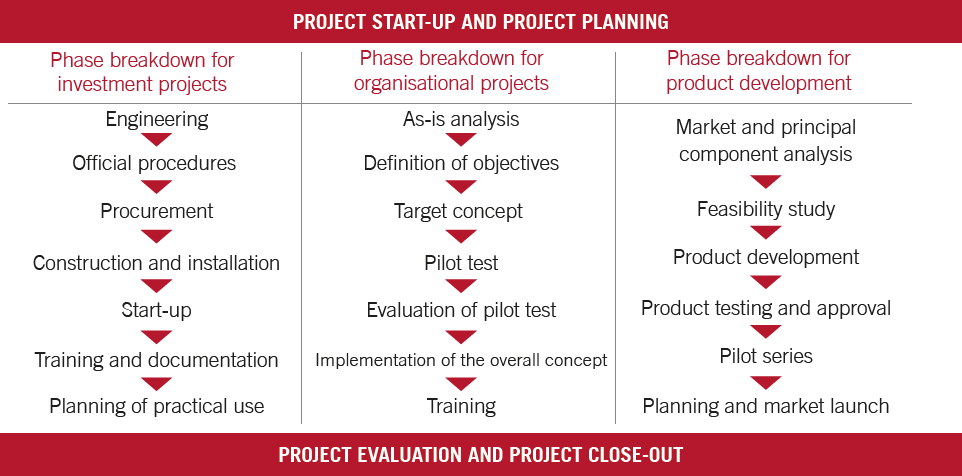Chapter 7 – The creation of the phase model¶
Part 2¶
Process models¶
Over the past decades, numerous process models have been developed that can be used by project managers. There are company-specific and industry-specific variants (phase or process models, stage gate models), they should each be used for a specific project type (e.g. IT-projects, projects in plant construction). However, there are also general procedure models (e.g. PRINCE 2) that can be adapted to the respective project type.
Overall, process models can consist of the following elements:
- project phases
- activities
- milestones
- milestone results
The advantages of process models are amongst others:
- manageable complexity by structuring
- establishment of a common understanding in the organisation
- assistance and instructions for the project manager (definition, creation and checking of interim results)
- risk minimisation (defined transit on points)
- transparency for the controller and key quality management tool
- error recognition and defect elimination, because the next phase cannot start until after the review
- interim results provide project team members with guidance and aid their fast integration in the project
- procedures involving sequential phases correspond to the behaviour of humans when solving complex tasks
There exist two models for the realisation of projects. The evolutionary model is based on a stage-by-stage upgrades (versions) and often used in software development. Whereas the incremental model specifies the requirements at the beginning of a project.
Phase plan¶
If the project budget and the timeframe have to be planned, a simple yet effective way of doing this is to create a phase plan. This process model divides a project up into individual phases, each phase begins or ends with a milestone or another measurable event. A new phase cannot start until the previous one is completed.
To do so, it is advised to create the phase model in a workshop with the team, maybe a standard phase model is useful here. As an orientation on how to name the phases, here is an example for each project type:

After each phase is defined, the next step is to estimate how much time and budget each phase needs. Estimating in a team offers great benefits, like creating a common basis for communication, bringing light to as many undisclosed assumptions and prerequisites relating to the project or it provides the earliest possible ascertainment of the total project costs.
To do this, there are two approaches for making an estimate.
Bottom-up
Starting from scratch, the values for each phase are estimated separately and later summed up.
Top-down
Starting from a total of 100 %, each phase is set in relation to each other. Then it is estimated, how much (in %) each phase contributes to the whole project.
Then all together is written down in a table:

Note
The phase model cannot only be displayed in tables, it can also be arranged in a chart that visualises the required time and costs per phase.
Start-up phase¶
In this phase, the decision for or against a project is made. It examines what the project is about and why it is important. Here the project plan is prepared and targets are specified, the project's organisational structures are set up and an initial risk analysis is carried out.
Proposal phase¶
In the second phase it's all about the project proposal. Here, the project is proposed to the client and a contract is made. Project goals, results and delivery items are further specified, the success factors are identified, the project team is assembled and content is aligned with relevant stakeholders. If necessary, the steering committee is set up.
Development phase¶
In this phase, project planning takes place throughout the project. First tasks, deadlines, costs, capacities, results and milestones are planned and recorded in a phase model or in a work breakdown structure. Procurement, contracts, reports and communications are planned and the project risks are analysed. It's important that the original plan is constantly updated and adapted during the project period.
Production operation phase¶
The activities to implement the individual measures are constantly coordinated. Work packages are released, the execution is monitored and the results (quality, time and costs) are constantly reviewed. It's important that there is a fluent exchange of information between all relevant stakeholders. If the implementation (actual state) deviates from the plan (target state), it must be controlled accordingly: priorities change, the plan is adjusted or resources are redistributed. Keep the stakeholders constantly informed.
Reworking phase (project close-out)¶
Finally, the project will be accepted by the client if the results and delivery items as well as their quality meets the expectations. The project manager checks the profitability, documents the results, concludes contracts and ensures that experiences can be used for future projects. In the end, the project team is dissolved.
Milestones¶
Milestones are usually at the beginning or at the end of a phase, but can also be set within one phase. Not only targets and actual dates are assigned to it, also planned and actual accumulated costs, as well as targeted milestone results (products). A milestone stands for a defined result (milestone content), linked to a completion date (milestone date).
Information
By preparing a milestone plan, which checks the timing of interim results and by using audits, reviews and assessments to check and evaluate the deliverables at the end of each phase, also quality management can be applied to process models.